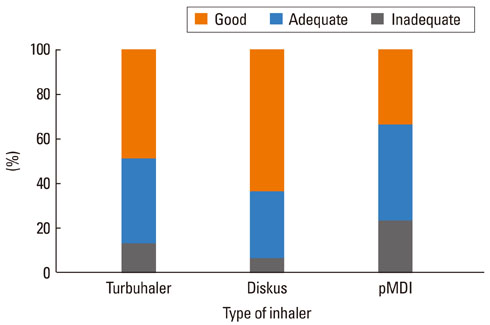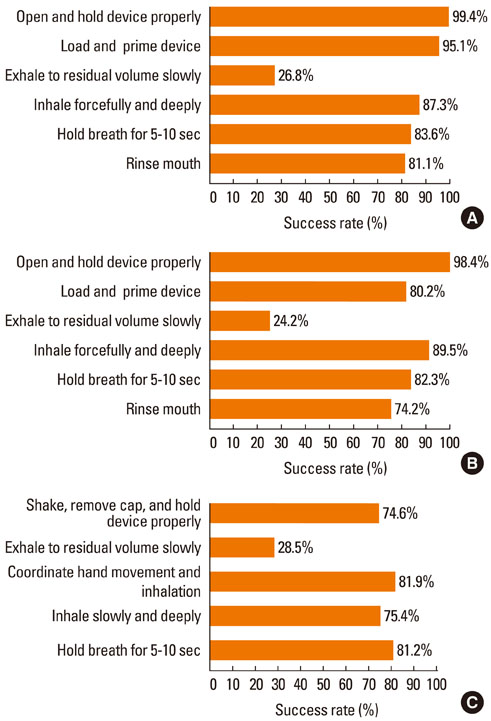Allergy Asthma Immunol Res.
2011 Jan;3(1):46-52. 10.4168/aair.2011.3.1.46.
Skills in Handling Turbuhaler, Diskus, and Pressurized Metered-Dose Inhaler in Korean Asthmatic Patients
- Affiliations
-
- 1Armed Forces Capital Hospital, Seongnam, Korea.
- 2Department of Internal Medicine, Seoul National University College of Medicine, Seoul, Korea.
- 3Institute of Allergy and Clinical Immunology, Seoul National University Medical Research Center, Seoul, Korea.
- 4Department of Internal Medicine, Seoul National University Bundang Hospital, Seongnam, Korea.
- 5Department of Internal Medicine, Inha University College of Medicine, Incheon, Korea.
- 6Department of Allergy and Clinical Immunology, Asan Medical Center, University of Ulsan College of Medicine, Seoul, Korea.
- 7Department of Internal Medicine, Hanyang University College of Medicine, Seoul, Korea.
- 8Department of Internal Medicine, Chosun University School of Medicine, Gwangju, Korea.
- 9Department of Internal Medicine, Kyungpook National University School of Medicine, Daegu, Korea.
- 10Department of Internal Medicine, Dong-A University College of Medicine, Busan, Korea.
- 11Department of Internal Medicine, Ilsan Paik Hospital, Inje University College of Medicine, Goyang, Korea.
- 12Department of Internal Medicine, Yonsei University College of Medicine, Seoul, Korea.
- 13Department of Internal Medicine, Dankook University College of Medicine, Cheonan, Korea. ykjee@dankook.ac.kr
- KMID: 2260377
- DOI: http://doi.org/10.4168/aair.2011.3.1.46
Abstract
- PURPOSE
The objective of this study was to evaluate skills in handling inhalers and factors associated with these skills among patients with asthma who had undergone treatment at special asthma and allergy clinics in Korea.
METHODS
We enrolled 78 subjects who used Turbuhaler and 145 who used Diskus for asthma control at special clinics in 10 university hospitals and visually assessed their skills in handling these inhalers. We also evaluated skills in 137 subjects who had used pressurized metered-dose inhalers (pMDIs) for symptom relief. Age, sex, duration of asthma and inhaler use, smoking status, monthly income, highest grade completed in school and previous instruction for handling inhalers were also measured to evaluate their association with overall inhaler skills.
RESULTS
Performance grade was inadequate for 12.8% of participants using Turbuhaler, 6.2% for Diskus, and 23.4% for pMDIs. The success rates for each step in handling the inhalers were relatively high except for the "exhale slowly to residual volume" step, in which success rates ranged from 24.2% to 28.5%. Older age, male sex, lower educational grade, and absence of previous instruction for handling inhalers were associated with inadequate inhaler technique in univariate analysis; however, only older age and absence of previous instruction remained significant independent risk factors in multivariate analysis.
CONCLUSIONS
Among Korean asthmatic patients in special asthma and allergy clinics, skills in handling their inhalers were mostly excellent; meanwhile, older age and absence of previous instruction for handling inhalers were associated with inadequate techniques.
Keyword
MeSH Terms
Figure
Cited by 1 articles
-
Treatment of allergic diseases in elderly
Ga-Young Ban, Hae-Sim Park
J Korean Med Assoc. 2015;58(1):49-54. doi: 10.5124/jkma.2015.58.1.49.
Reference
-
1. Global Initiative for Asthma. Global Strategy for asthma management and prevention. 2009. Bethesda: National Institutes of Health.2. van Beerendonk I, Mesters I, Mudde AN, Tan TD. Assessment of the inhalation technique in outpatients with asthma or chronic obstructive pulmonary disease using a metered-dose inhaler or dry powder device. J Asthma. 1998; 35:273–279.3. Campos A, Díaz MA, Muñoz MP, Liñana JJ, Martínez M, Lanuza MD. Assessment of the inhalation technique in asthmatic patients: a comparative study of three aerosol devices. Allergol Immunopathol (Madr). 1998; 26:47–51.4. Kamps AW, van Ewijk B, Roorda RJ, Brand PL. Poor inhalation technique, even after inhalation instructions, in children with asthma. Pediatr Pulmonol. 2000; 29:39–42.5. Crompton GK. Problems patients have using pressurized aerosol inhalers. Eur J Respir Dis Suppl. 1982; 119:101–104.6. Kim SH, Kwak HJ, Kim TB, Chang YS, Jeong JW, Kim CW, Yoon HJ, Jee YK. Inappropriate techniques used by internal medicine residents with three kinds of inhalers (a metered dose inhaler, Diskus, and Turbuhaler): changes after a single teaching session. J Asthma. 2009; 46:944–950.7. Fink JB, Rubin BK. Problems with inhaler use: a call for improved clinician and patient education. Respir Care. 2005; 50:1360–1374. discussion 74-5.8. Lavorini F, Magnan A, Dubus JC, Voshaar T, Corbetta L, Broeders M, Dekhuijzen R, Sanchis J, Viejo JL, Barnes P, Corrigan C, Levy M, Crompton GK. Effect of incorrect use of dry powder inhalers on management of patients with asthma and COPD. Respir Med. 2008; 102:593–604.9. Self TH, Pinner NA, Sowell RS, Headley AS. Does it really matter what volume to exhale before using asthma inhalation devices? J Asthma. 2009; 46:212–216.10. Plaza V, Sanchis J. Medical personnel and patient skill in the use of metered dose inhalers: a multicentric study. CESEA Group. Respiration. 1998; 65:195–198.11. Hanania NA, Wittman R, Kesten S, Chapman KR. Medical personnel's knowledge of and ability to use inhaling devices. Metered-dose inhalers, spacing chambers, and breath-actuated dry powder inhalers. Chest. 1994; 105:111–116.12. Carrión Valero F, Maya Martínez M, Fontana Sanchis I, Díaz López J, Marín Pardo J. Inhalation technique in patients with chronic respiratory diseases. Arch Bronconeumol. 2000; 36:236–240.13. Cimas JE, González Vázquez de Prada I, del Castillo Arévalo F. The validation of checklists for the inhalation technic for the pressurized cartridge and the Turbuhaler. Arch Bronconeumol. 1999; 35:15–19.14. Melani AS, Zanchetta D, Barbato N, Sestini P, Cinti C, Canessa PA, Aiolfi S, Neri M. Inhalation technique and variables associated with misuse of conventional metered-dose inhalers and newer dry powder inhalers in experienced adults. Ann Allergy Asthma Immunol. 2004; 93:439–446.15. Casset A, Rebotier P, Lieutier-Colas F, Glasser N, Heitz C, Saigne J, Pauli G, de Blay F. Pharmacists' role in the management of asthma: a survey of 120 pharmacists in Bas-Rhin. Rev Mal Respir. 2004; 21:925–933.16. Paterson IC, Crompton GK. Use of pressurised aerosols by asthmatic patients. Br Med J. 1976; 1:76–77.17. Allen SC, Prior A. What determines whether an elderly patient can use a metered dose inhaler correctly? Br J Dis Chest. 1986; 80:45–49.18. Allen SC. Competence thresholds for the use of inhalers in people with dementia. Age Ageing. 1997; 26:83–86.19. Connolly MJ. Inhaler technique of elderly patients: comparison of metered-dose inhalers and large volume spacer devices. Age Ageing. 1995; 24:190–192.20. Blaiss MS. Part II: Inhaler technique and adherence to therapy. Curr Med Res Opin. 2007; 23:Suppl 3. S13–S20.21. Crompton GK, Barnes PJ, Broeders M, Corrigan C, Corbetta L, Dekhuijzen R, Dubus JC, Magnan A, Massone F, Sanchis J, Viejo JL, Voshaar T. The need to improve inhalation technique in Europe: a report from the Aerosol Drug Management Improvement Team. Respir Med. 2006; 100:1479–1494.22. Kim SG, Jang AS, Kim YK, Lee S, Seo JP, Yang SW, Choi SI, Park SH, Lee KR, Park JH. The effect of patient education on correct use of metered dose inhalers in patients with asthma. J Asthma Allergy Clin Immunol. 2000; 20:695–701.23. Kamin WE, Genz T, Roeder S, Scheuch G, Cloes R, Juenemann R, Trammer T. The inhalation manager: a new computer-based device to assess inhalation technique and drug delivery to the patient. J Aerosol Med. 2003; 16:21–29.24. van der Palen J, Klein JJ, Kerkhoff AH, van Herwaarden CL, Zielhuis GA, Seydel ER. Inhalation technique of 166 adult asthmatics prior to and following a self-management program. J Asthma. 1999; 36:441–447.25. Park SY, Cho YS, Ji HS, Lee J, Kim YY, Lee TH, Lee CK, Yoo B, Moon HB. Evaluation of the inhalation performance in patients with asthma. J Asthma Allergy Clin Immunol. 2003; 23:781–787.26. Goodman DE, Israel E, Rosenberg M, Johnston R, Weiss ST, Drazen JM. The influence of age, diagnosis, and gender on proper use of metered-dose inhalers. Am J Respir Crit Care Med. 1994; 150:1256–1261.27. Walia M, Paul L, Satyavani A, Lodha R, Kalaivani M, Kabra SK. Assessment of inhalation technique and determinants of incorrect performance among children with asthma. Pediatr Pulmonol. 2006; 41:1082–1087.28. Williams MV, Baker DW, Honig EG, Lee TM, Nowlan A. Inadequate literacy is a barrier to asthma knowledge and self-care. Chest. 1998; 114:1008–1015.29. Lee JK, Yang YH. Evaluation of an education program for patients with asthma who use inhalers. J Korean Acad Nurs. 2010; 40:202–212.
- Full Text Links
- Actions
-
Cited
- CITED
-
- Close
- Share
- Similar articles
-
- Assessment of Techniques for Using Inhalers in Primary Care Physicians
- The Evaluation of an Education Program for Using an Inhaler Devices in Childhood Asthma
- Assessment of Inhaler Satisfaction and Determinants of High Satisfaction Among Korean COPD Patients
- Comparing Inhaler Use Technique Based on Inhaler Type in Elderly Patients with Respiratory Disease
- Comparison of therapeutic effect of metered dose inhaler with spacer and nebulizer in acute childhood asthma



